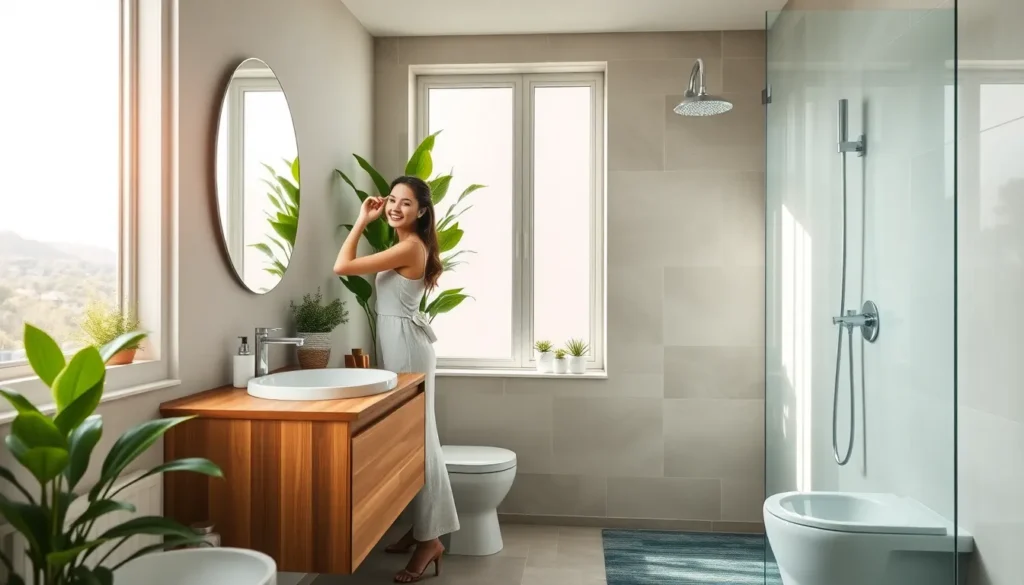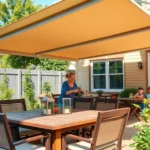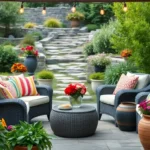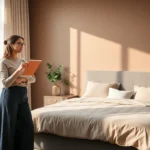We’re living in an era where environmental consciousness meets stunning home design and nowhere is this more evident than in today’s eco-friendly bathroom transformations. Creating a green bathroom isn’t just about reducing your carbon footprint – it’s about crafting a sustainable sanctuary that saves money while improving your daily routine.
From water-saving fixtures to sustainable materials that’ll make your space shine we’ve discovered countless ways to transform your bathroom into an eco-warrior’s dream. Whether you’re planning a complete renovation or looking for simple swaps that make a big impact these green bathroom ideas prove that being environmentally responsible doesn’t mean compromising on style.
Ready to jump into a industry where luxury meets sustainability? We’ll show you how to create a bathroom that’s not only gorgeous but also gentle on the planet and your wallet.
Eco-Friendly Lighting Solutions for Your Green Bathroom
Transforming your bathroom lighting choices directly impacts both energy consumption and environmental sustainability. We’ll explore innovative lighting answers that reduce electricity costs while creating the perfect ambiance for your eco-conscious space.
LED Light Fixtures and Smart Controls
LED fixtures consume up to 80% less energy than traditional incandescent bulbs while lasting 25 times longer. We recommend installing dimmer-compatible LED vanity lights that provide optimal task lighting for daily grooming routines. Smart motion sensors automatically turn lights on when entering the bathroom and shut them off after 30 seconds of inactivity.
Programmable smart switches allow us to schedule lighting based on daily usage patterns. Timer controls ensure bathroom exhaust fans with integrated LED lights operate only when needed. Color-changing LED strips behind mirrors create spa-like atmospheres while using minimal electricity.
Voice-activated smart bulbs eliminate the need to touch light switches with wet hands. We suggest choosing ENERGY STAR certified LED fixtures that meet strict efficiency guidelines. Daylight-balanced LEDs at 5000K temperature reduce eye strain during morning and evening routines.
Natural Light Maximization Techniques
Strategic window placement floods bathrooms with free daylight while reducing reliance on artificial lighting. We can install larger windows or add skylights to brighten interior spaces naturally. Frosted glass maintains privacy while allowing maximum light penetration throughout the day.
Light tubes channel sunlight from rooftops into windowless bathrooms through reflective tunnels. Mirror placement opposite windows doubles available natural light by reflecting rays across room surfaces. Glass shower doors replace opaque curtains to maintain open sight lines and light flow.
Solar-powered ventilation fans with built-in LED lights harness renewable energy for dual functionality. We recommend positioning mirrors at angles that capture and redirect morning sunlight. Light-colored paint on walls and ceilings reflects natural light more effectively than darker tones.
Clerestory windows near ceiling lines provide privacy while maximizing daylight entry. Interior glass panels between bathrooms and adjacent rooms share natural light from multiple sources.
Water-Saving Fixtures That Make a Difference

Water fixtures represent the most impactful area where we can transform our bathrooms into eco-friendly spaces. Smart water management reduces both environmental impact and monthly utility bills significantly.
Low-Flow Toilets and Dual-Flush Systems
Low-flow toilets revolutionize bathroom water consumption by using just 1.6 gallons per flush compared to older models that waste 3–5 gallons with each use. We’ve found these modern systems maintain excellent flushing power while cutting water usage by more than half.
Dual-flush systems take water savings even further with their innovative two-button design. Light flushes use approximately 0.8 gallons for liquid waste while full flushes consume around 1.6 gallons for solid waste. Advanced models we’ve tested can operate with as little as 0.5 gallons for the low-flush option.
Household water reduction becomes dramatic when we install these systems correctly. Studies show dual-flush toilets can decrease total home water consumption by up to 40% when family members use the appropriate flush settings consistently.
Water-Efficient Showerheads and Faucets
Modern showerheads deliver exceptional performance while using 2.0 gallons per minute or less, dramatically improving upon older models that consume over 2.5 gpm. We recommend choosing models that maintain strong water pressure through innovative flow restriction technology.
Aerator technology in water-efficient faucets mixes air with water to create satisfying flow rates as low as 1.0 gpm without sacrificing functionality. These fixtures feel powerful even though their reduced consumption rates.
Installation benefits extend beyond water savings to include reduced energy costs for heating water. We notice important utility bill reductions when combining efficient showerheads with low-flow faucet aerators throughout the bathroom.
Greywater Recycling Options
Collection systems capture and redirect water from showers, sinks, and baths for secondary uses like toilet flushing and industry irrigation. We can carry out these answers ranging from simple manual buckets to sophisticated automated plumbing networks.
Reuse applications make previously wasted water valuable for non-potable purposes throughout our homes. Simple greywater collection reduces fresh water demand while supporting sustainable living practices.
System varieties accommodate different budgets and installation complexities, from DIY collection containers to professionally installed whole-house greywater plumbing answers. We find that even basic manual systems provide meaningful water conservation benefits for environmentally conscious homeowners.
Sustainable Material Choices for Bathroom Renovations
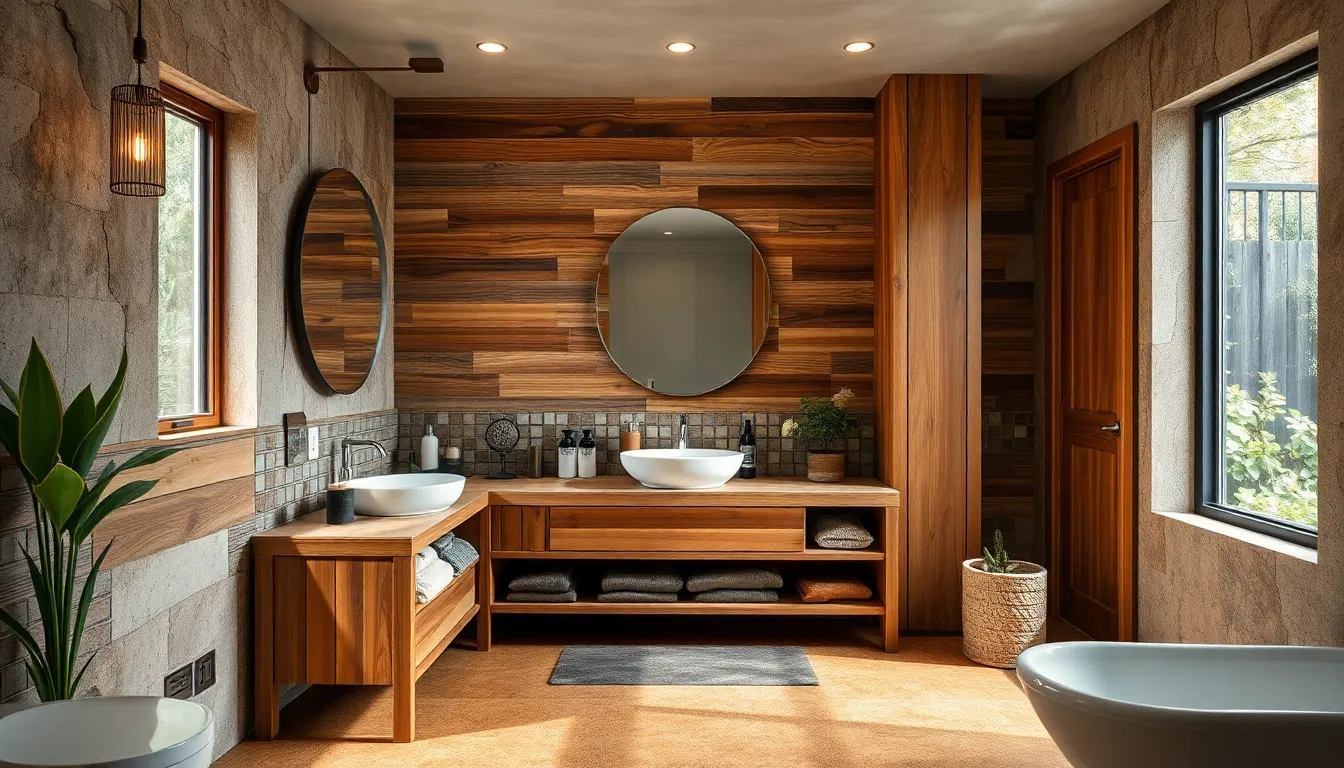
Selecting eco-friendly materials for our bathroom renovation projects creates healthier indoor environments while reducing environmental impact. We’ll explore the most effective sustainable options that combine durability with environmental responsibility.
Bamboo and Reclaimed Wood Features
Bamboo stands out as one of the most renewable materials available, maturing much faster than traditional hardwoods while offering superior strength compared to many conventional wood species. We can incorporate bamboo into flooring installations, cabinet construction, wall panels, and bathroom accessories like shelving or bath mats.
Reclaimed wood brings rustic charm to our green bathroom designs while actively reducing deforestation through timber repurposing. Sourcing this material from old structures gives us unique character pieces that tell environmental stories. We find reclaimed wood particularly effective for vanity tops, accent walls, and custom storage answers.
Recycled Glass Tiles and Countertops
Recycled glass tiles transform post-consumer and post-industrial glass waste into stunning bathroom surfaces, diverting materials from landfills while requiring significantly less energy to produce than new alternatives. These tiles offer us an incredible range of colors and finishes that enhance both aesthetic appeal and environmental benefits.
Glass countertops made from recycled materials provide durable, non-porous surfaces that resist stains and bacteria naturally. We appreciate how these surfaces reflect light beautifully while maintaining easy cleaning requirements for busy bathroom environments.
Natural Stone and Cork Flooring
Natural stone materials like slate and limestone deliver timeless durability that lasts decades with proper maintenance. When we source these materials locally, we dramatically reduce transportation emissions while supporting regional economies.
Cork flooring emerges as an exceptional sustainable choice, harvested from cork oak tree bark without harming the living tree. We value cork’s natural insulation properties, inherent warmth, and water resistance that makes it perfectly suited for bathroom environments. This renewable material naturally resists mold and mildew while providing comfortable underfoot cushioning.
Energy-Efficient Heating and Ventilation Systems
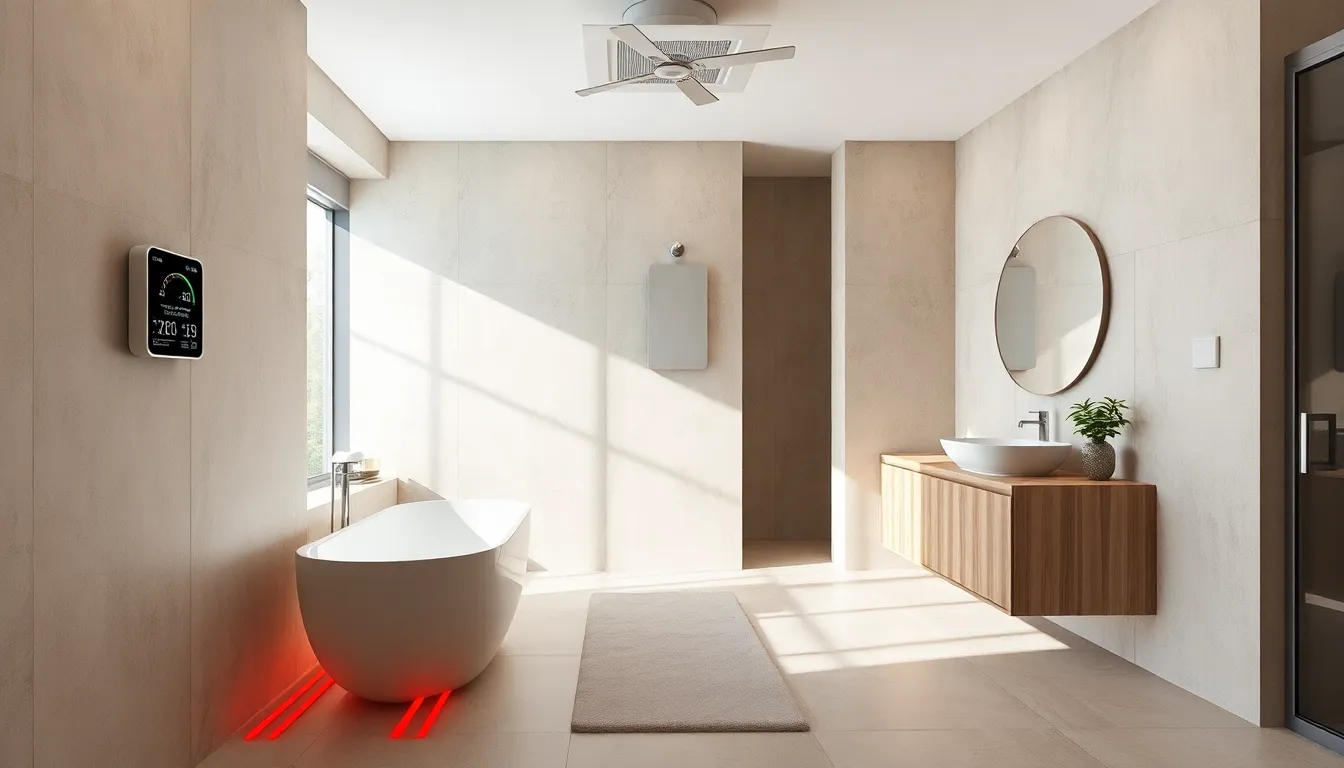
Creating a comfortable bathroom environment while maintaining eco-friendly practices requires smart heating and ventilation choices. We’ll explore two key technologies that significantly reduce energy consumption without compromising performance.
Programmable Thermostats for Radiant Floor Heating
Programmable thermostats transform radiant floor heating into an incredibly efficient system. These devices allow us to control temperature precisely, ensuring heat operates only when needed and reducing energy consumption by up to 30% compared to constant heating.
Smart scheduling capabilities enable us to warm floors before morning routines while maintaining lower temperatures during unoccupied hours. The system heats floors directly rather than warming air, making it more efficient than traditional heating methods when combined with proper insulation and natural materials.
Installation costs typically range from $150 to $400 for programmable controls, but the energy savings often recoup this investment within two years. Advanced models offer smartphone connectivity, allowing remote temperature adjustments and monitoring energy usage patterns.
Zone control features let us heat exact bathroom areas independently, preventing energy waste in unused spaces. This targeted approach works particularly well with natural stone or tile flooring, which retains and distributes heat effectively throughout the room.
Energy Star Rated Exhaust Fans
Energy Star rated exhaust fans provide efficient ventilation while minimizing electricity usage. These fans remove moisture and pollutants from bathrooms, reducing the need for additional heating or cooling systems that compensate for poor air quality.
Performance ratings show these fans move air 20% more efficiently than standard models while producing less noise during operation. The improved ventilation helps prevent mold and mildew growth, protecting our sustainable bathroom materials and maintaining healthy indoor air quality.
Installation of Energy Star fans typically costs between $100 and $300, including professional setup and electrical connections. Models with humidity sensors automatically activate when moisture levels rise, ensuring optimal ventilation without manual operation.
Advanced features include timer controls and motion sensors that prevent unnecessary energy consumption while maintaining consistent air circulation. These smart functions complement our other green bathroom technologies, creating an integrated system that maximizes efficiency and comfort.
Non-Toxic Paint and Finishing Options

Choosing healthier finishes transforms your bathroom into a cleaner environment while maintaining beautiful aesthetics. We’ll explore paint and finishing alternatives that eliminate harmful chemicals from your daily space.
VOC-Free Paint Selection
Natural ingredient paints reduce allergy inducing toxins while providing excellent coverage and durability. We recommend selecting products specifically labeled as non-toxic since these formulations minimize impact on indoor air quality and create safer environments for families.
Low VOC wallpaper options offer attractive alternatives when you want decorative surfaces without traditional paint applications. These eco-friendly wallpapers use natural materials and water based adhesives that won’t release harmful chemicals into your bathroom air.
Zero emission paint formulas contain plant based pigments and natural binders that deliver vibrant colors without compromising health. We’ve found these paints perform exceptionally well in humid bathroom conditions while maintaining their finish integrity over time.
Natural Sealers and Stains
Chemical free wood sealers protect vanities and cabinets using plant derived oils and waxes instead of synthetic compounds. These natural products penetrate deeply into wood surfaces while allowing the material to breathe naturally and resist moisture damage.
Reclaimed wood finishing combines sustainability with rustic charm when we apply eco-friendly stains to salvaged materials. Using reclaimed wood for bathroom vanities reduces deforestation impact while natural stains enhance the unique character of weathered timber.
Water based polyurethane alternatives provide durable protection without toxic fumes or harsh chemical odors. We prefer these safer options because they dry quickly and offer excellent resistance to humidity while maintaining indoor air quality standards.
Plant based stain formulas deliver rich color variations using ingredients like iron oxide and plant extracts. These natural alternatives create beautiful wood tones without releasing volatile organic compounds that can accumulate in enclosed bathroom spaces.
Eco-Conscious Storage and Organization Solutions
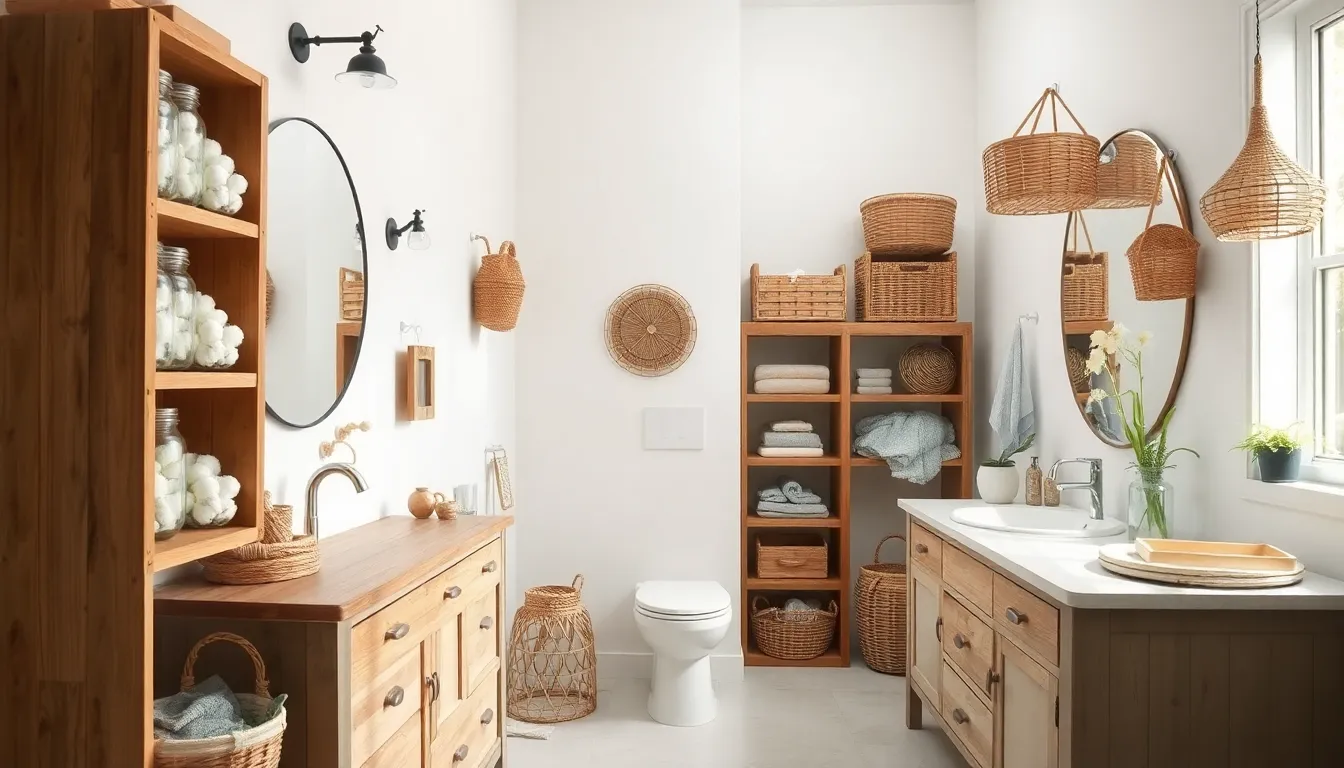
Smart storage answers can transform your bathroom into an organized sanctuary while supporting your environmental goals. We’ve found that combining sustainability with functionality creates spaces that work better for daily routines and the planet.
Repurposed and Upcycled Storage Ideas
Mason jars become versatile organizers when we repurpose them for storing cotton balls, bath salts, or homemade scrubs. These glass containers offer clear visibility of contents while reducing plastic waste in our bathrooms.
Wooden crates provide rustic charm as open shelving units for towels and toiletries. We can stack vintage apple crates or wine boxes to create custom storage towers that add character to any bathroom design.
Old dressers transform into unique vanities with minimal modification, offering abundant drawer space for organizing personal care items. Converting furniture pieces we already own eliminates the need for new purchases while creating one of a kind storage answers.
Hanging baskets made from wicker maximize vertical wall space for storing extra toilet paper or cleaning supplies. Natural materials like seagrass or rattan bring organic textures while keeping essentials within easy reach.
Ladder shelves constructed from reclaimed wood create stunning display areas for decorative bottles and plants. These vertical storage pieces work especially well in smaller bathrooms where floor space is limited.
Sustainable Cabinet Materials
Bamboo cabinets offer exceptional sustainability since this grass grows up to 3 feet per day and regenerates without replanting. We appreciate how bamboo’s natural strength rivals traditional hardwoods while maintaining a lighter environmental footprint.
Recycled glass countertops divert waste from landfills while creating beautiful surfaces that resist stains and scratches. These materials incorporate post consumer glass bottles and windows, transforming discarded items into functional bathroom elements.
Low VOC wood finishes protect indoor air quality by eliminating harmful chemicals that can cause headaches and respiratory irritation. We recommend water based polyurethane and plant derived stains that maintain wood’s natural beauty without toxic emissions.
Reclaimed wood cabinets preserve forest resources by giving new life to materials from old barns, factories, or demolished buildings. Each piece tells a story while reducing demand for freshly harvested timber.
Cork cabinet fronts provide natural antimicrobial properties that resist mold and mildew in humid bathroom environments. This renewable bark material harvests without harming oak trees, making it an excellent choice for eco conscious renovations.
Green Cleaning Products and Natural Alternatives
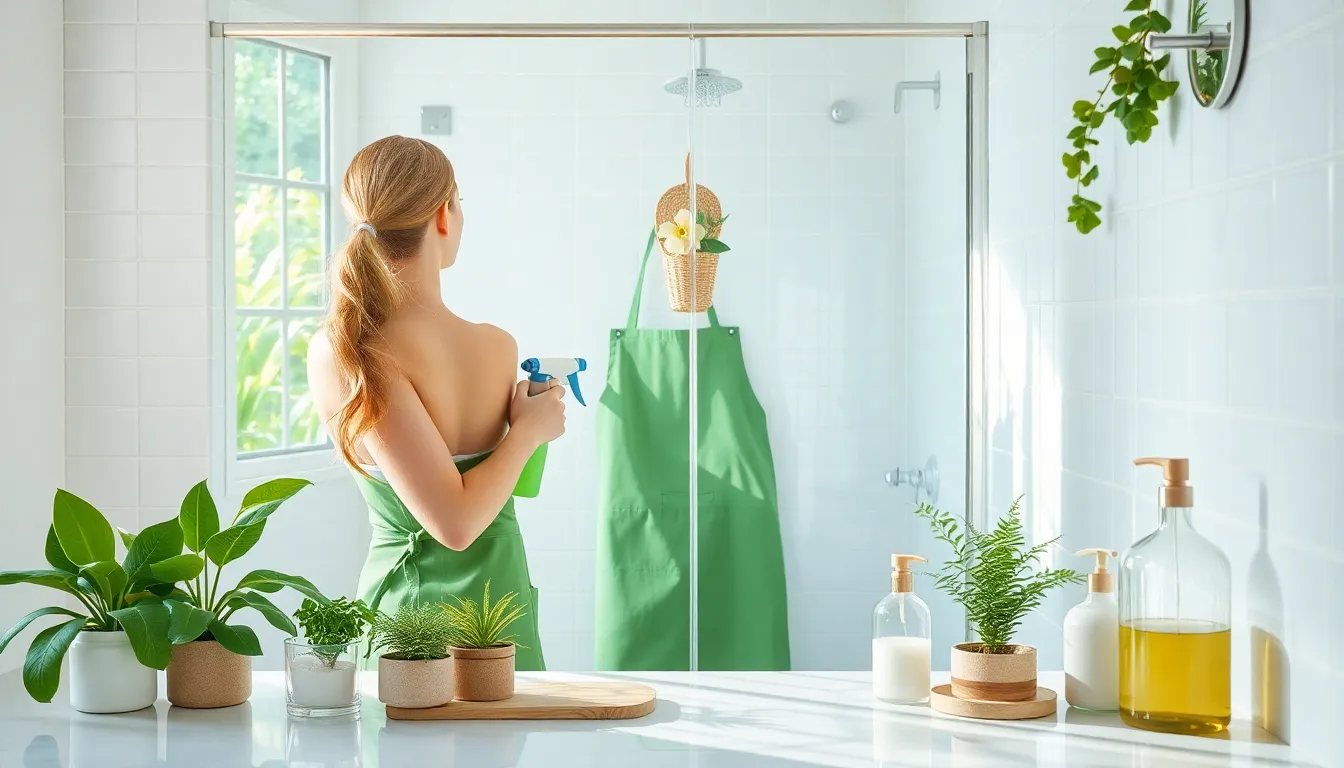
Maintaining our newly sustainable bathrooms requires cleaning products that align with our eco-friendly goals. We can achieve spotless results while protecting both our health and the environment through natural alternatives and carefully chosen commercial products.
Homemade Cleaning Solution Recipes
Baking soda and vinegar combinations create powerful natural scrubs that tackle soap scum and mineral deposits without harsh chemicals. Mix equal parts baking soda and white vinegar to form a paste that effortlessly removes grime from tiles, tubs, and shower doors. This combination works particularly well on calcium buildup around faucets and showerheads.
Lemon juice and olive oil blends provide gentle polishing power for natural stone surfaces and fixtures. Combine two parts lemon juice with one part olive oil to create a solution that cleans and conditions marble countertops and wooden vanities. The citric acid in lemon naturally disinfects while the oil adds protective moisture.
Castile soap answers offer versatile cleaning power for multiple bathroom surfaces. Mix two tablespoons of liquid castile soap with one gallon of warm water to create an all-purpose cleaner that works on floors, walls, and fixtures. We can add essential oils like tea tree or lavender for additional antimicrobial properties and pleasant scents.
White vinegar and water mixtures excel at removing water spots and soap residue from glass shower doors and mirrors. Combine equal parts white vinegar and distilled water in a spray bottle for streak-free cleaning that costs significantly less than commercial glass cleaners.
Environmentally Safe Commercial Products
Products labeled as non-toxic and biodegradable ensure our cleaning routine doesn’t introduce harmful chemicals into our homes or waterways. Look for certifications from third-party organizations like Green Seal or EcoLogo that verify environmental claims and safety standards.
Minimal packaging options reduce waste while delivering effective cleaning power. Choose concentrated formulas that require less plastic packaging and allow us to refill containers multiple times. Powder-based cleaners often come in recyclable cardboard boxes instead of plastic bottles.
Plant-based ingredient formulations provide cleaning effectiveness without synthetic chemicals that can irritate skin or compromise indoor air quality. These products typically use ingredients like coconut-derived surfactants and plant-based enzymes that break down dirt and grime naturally.
Refillable cleaning systems minimize packaging waste and reduce our environmental footprint over time. Many eco-friendly brands now offer concentrated pods or refill stations that allow us to reuse spray bottles and reduce single-use plastic consumption by up to 90%.
Water-Wise Landscaping for Bathroom Windows
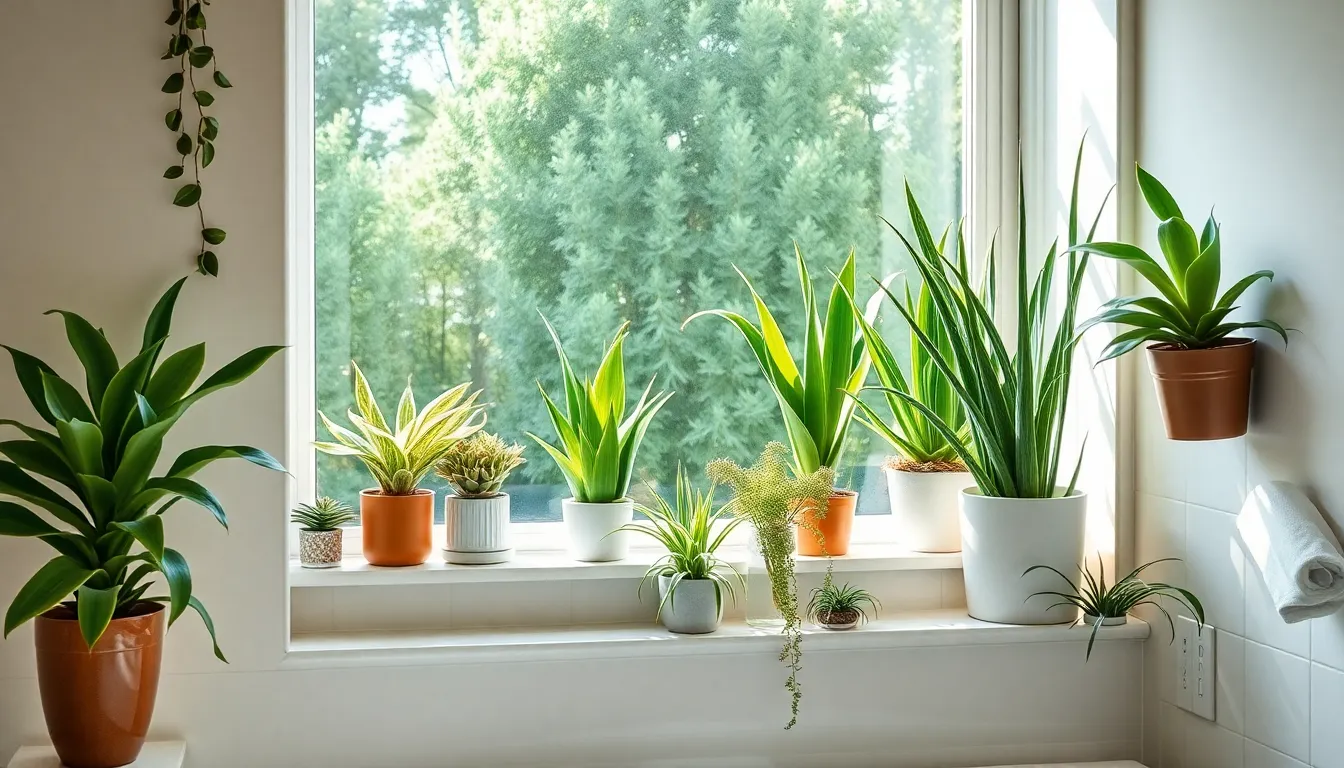
Strategic plant placement around bathroom windows creates natural privacy while supporting our eco-friendly design goals. These green answers work perfectly with water conservation efforts and enhance the overall sustainability of our bathroom space.
Drought-Resistant Plants for Privacy
Succulents offer exceptional privacy screening for bathroom windows while requiring minimal water maintenance. We can position varieties like jade plants, aloe vera, or echeveria on windowsills to create natural barriers that thrive in humid bathroom conditions. Cacti provide another excellent option, with their upright growth patterns creating effective visual screens without demanding frequent watering.
These plants excel in low maintenance environments, making them ideal for busy households or those committed to water conservation. Their thick, fleshy leaves store water efficiently, allowing them to flourish even when we forget occasional watering sessions. Many succulent varieties grow tall enough to provide complete window coverage while maintaining their compact footprint.
Placement strategies maximize both privacy and plant health by positioning larger specimens at window centers and smaller ones along edges. We can create layered arrangements using different heights and textures to enhance visual appeal while maintaining our water wise approach. Most drought resistant plants adapt well to bathroom humidity levels, creating perfect growing conditions without additional water requirements.
Air-Purifying Indoor Plants
Ferns transform bathroom air quality while adding lush, natural beauty to our eco-friendly spaces. Boston ferns and maidenhair ferns excel at removing indoor air pollutants while thriving in the naturally humid bathroom environment. These plants effectively filter toxins from cleaning products and other household chemicals commonly found in bathroom spaces.
Spider plants provide powerful air purification benefits alongside easy propagation opportunities for expanding our green bathroom collection. We can hang these versatile plants near windows or place them on floating shelves to maximize their air cleaning potential. Their cascading growth pattern creates attractive natural curtains while continuously working to improve indoor air quality.
Snake plants offer exceptional low light tolerance and air purification capabilities, making them perfect for bathrooms with limited natural lighting. These sturdy plants remove formaldehyde and other volatile organic compounds while requiring minimal care and water. We can position them in corners or near vanities where they’ll effectively clean the air without interfering with daily routines.
Peace lilies combine beautiful white blooms with superior air filtering abilities, removing ammonia, benzene, and other common bathroom pollutants. Their elegant appearance enhances our sustainable bathroom aesthetic while providing measurable improvements to indoor air quality. These plants signal when they need water by slightly drooping their leaves, making maintenance simple and efficient.
Smart Technology Integration for Resource Conservation

Smart technology transforms ordinary bathrooms into efficient, resource-conscious spaces that automatically optimize energy and water usage. These innovative systems not only reduce environmental impact but also provide long-term cost savings through intelligent monitoring and control.
Water Usage Monitoring Systems
Water usage monitoring systems track consumption patterns and provide real-time insights into your bathroom’s efficiency. These smart devices connect to your plumbing infrastructure to measure flow rates, detect leaks instantly, and identify wasteful usage habits that might otherwise go unnoticed.
Install smart water meters that send alerts directly to your smartphone when unusual consumption occurs. These systems can detect even minor leaks that waste thousands of gallons annually, helping you address issues before they become costly problems. Many models integrate with home automation platforms to provide comprehensive water management across your entire house.
Digital leak detection sensors placed near toilets, sinks, and showers offer 24/7 monitoring capabilities. These wireless devices immediately notify you of moisture buildup or standing water, preventing potential water damage while ensuring optimal resource conservation. Advanced models include temperature monitoring to prevent pipe freezing and burst pipes.
Smart shower timers and flow controllers help family members develop water-conscious habits. These devices display real-time usage data and can automatically reduce flow after preset time limits, making conservation feel natural rather than restrictive. Some systems gamify the experience by tracking savings and celebrating conservation milestones.
Automated Lighting and Temperature Controls
Automated lighting systems eliminate energy waste by responding to occupancy and natural light levels throughout the day. Smart motion sensors detect when someone enters or leaves the bathroom, automatically adjusting LED fixtures to provide optimal illumination while minimizing electricity consumption.
Programmable smart switches learn your daily routines and adjust lighting schedules accordingly. These systems can gradually dim lights during evening hours to support natural sleep cycles while ensuring adequate visibility for safety. Integration with sunrise/sunset schedules maximizes natural light usage and reduces reliance on artificial lighting.
Smart temperature controls maintain comfortable conditions without constant manual adjustments. Digital thermostats connected to radiant floor heating systems can reduce energy consumption by up to 30% through precise scheduling and zone-based control. These systems warm floors only when needed, eliminating the waste associated with traditional always-on heating methods.
Humidity sensing ventilation fans automatically activate when moisture levels rise above optimal ranges. These Energy Star rated units remove excess humidity efficiently while consuming minimal electricity, preventing mold growth and maintaining healthy indoor air quality. Advanced models include variable speed controls that adjust fan power based on actual moisture levels rather than running at full capacity continuously.
Budget-Friendly DIY Green Bathroom Projects

We’ll explore cost-effective ways to create an eco-friendly bathroom that won’t strain your budget. These projects range from quick afternoon swaps to rewarding weekend transformations.
Simple Swaps for Immediate Impact
Green shower curtains instantly update your bathroom’s appearance without requiring any renovation work. We recommend choosing organic cotton or hemp materials that resist mold and mildew naturally while adding the perfect pop of color to your space.
Eco-friendly towels and bath mats in various shades of green create a cohesive look throughout your bathroom. Look for bamboo fiber or organic cotton options that feel luxurious while supporting sustainable manufacturing practices.
Natural lighting answers like green-tinted LED bulbs reduce energy consumption by up to 80% compared to traditional incandescent bulbs. String lights with green shades around mirrors or windows add ambient lighting that creates a spa-like atmosphere.
Living plants such as snake plants, pothos, or spider plants purify your bathroom air while adding natural green elements. These low-maintenance options thrive in humid environments and require minimal care to flourish.
Green accent pieces including soap dispensers, toothbrush holders, and storage containers tie your design together effortlessly. Choose recycled glass or bamboo materials to maintain your eco-conscious theme while staying within budget.
Weekend Projects with Maximum Benefits
Fresh paint application on walls and ceilings transforms your entire bathroom space over a single weekend. We suggest using low-VOC or zero-VOC paints in sage green, forest green, or mint green to create a calming environment while maintaining healthy indoor air quality.
Tile accent walls in the shower area add visual interest and can be completed with basic DIY skills. Green subway tiles, mosaic patterns, or natural stone create stunning focal points that increase your home’s value significantly.
Custom shower niches built with green tiles provide both storage and style enhancement. These functional additions organize your shower essentials while showcasing beautiful tilework that complements your overall design theme.
Reclaimed wood shelving adds rustic charm while supporting sustainable practices through material reuse. We recommend sealing the wood with eco-friendly finishes to protect against moisture while maintaining the natural grain patterns.
Vibrant wallpaper installation on accent walls creates dramatic transformations without major renovations. Choose botanical prints, geometric patterns, or solid green designs that reflect your personal style while adding personality to your space.
Conclusion
Creating a green bathroom doesn’t have to be overwhelming or expensive. We’ve shown you that small changes can make a big difference for both the environment and your wallet.
The beauty of sustainable bathroom design lies in its flexibility. Whether you’re ready for a complete renovation or prefer simple weekend projects you can start wherever your budget and timeline allow.
Your green bathroom journey is eventually an investment in your home’s future value and your family’s health. With smart technology integration and eco-friendly materials you’ll enjoy lower utility bills while contributing to a healthier planet.
Every water-saving fixture LED light and non-toxic product you choose moves us closer to more sustainable living. Your bathroom transformation can inspire others and create lasting positive change that extends far beyond your home.
Frequently Asked Questions
What makes a bathroom transformation eco-friendly?
An eco-friendly bathroom transformation involves incorporating sustainable materials, water-saving fixtures, energy-efficient lighting, and non-toxic finishes. It focuses on reducing environmental impact while creating a healthier indoor environment through choices like bamboo flooring, low-flow toilets, LED lighting, and VOC-free paints that benefit both your family and the planet.
How much can water-saving fixtures reduce my utility bills?
Water-saving fixtures like low-flow toilets and efficient showerheads can reduce water consumption by 20-60%. This translates to significant savings on monthly water bills, often paying for themselves within 1-2 years. Combined with energy-efficient heating systems, homeowners typically see 15-30% reduction in overall bathroom-related utility costs.
What are the best sustainable materials for bathroom renovations?
Top sustainable bathroom materials include bamboo (fast-growing and moisture-resistant), reclaimed wood, recycled glass tiles, and natural stone. These materials are durable, aesthetically pleasing, and have lower environmental impact than traditional options. They also contribute to better indoor air quality and can increase home value.
Can I create an eco-friendly bathroom on a tight budget?
Yes! Budget-friendly options include DIY projects like applying low-VOC paint, installing reclaimed wood shelving, switching to organic cotton shower curtains, and using energy-efficient LED bulbs. Simple swaps and weekend projects can create significant environmental impact without major renovation costs, making green bathrooms accessible to all budgets.
How do smart technologies help make bathrooms more sustainable?
Smart bathroom technologies include water usage monitoring systems that track consumption and detect leaks, automated lighting controls that optimize energy use, and programmable thermostats for efficient heating. These innovations provide real-time data to reduce waste, lower utility bills, and minimize environmental impact through intelligent resource management.
What lighting options are most energy-efficient for bathrooms?
LED light fixtures are the most energy-efficient choice, using 75% less energy than traditional bulbs. Dimmer-compatible vanity lights, smart motion sensors, and programmable switches further optimize energy consumption. Maximizing natural light through strategic window placement and using solar-powered ventilation fans also significantly reduce electricity usage.
Are homemade green cleaning products effective for bathroom maintenance?
Homemade green cleaning products using ingredients like vinegar, baking soda, and lemon are highly effective for bathroom cleaning. They’re non-toxic, cost-effective, and environmentally safe while maintaining cleanliness standards. These solutions eliminate harsh chemicals, improve indoor air quality, and reduce packaging waste from commercial products.
What plants work best for bathroom sustainability and air purification?
Drought-resistant and air-purifying plants like snake plants, pothos, and spider plants thrive in bathroom humidity while improving air quality. These plants require minimal water, filter indoor pollutants, and add natural beauty to your space. They support water-wise landscaping principles and contribute to a healthier bathroom environment.

